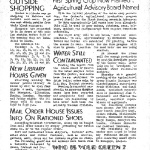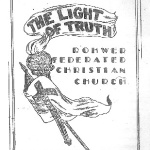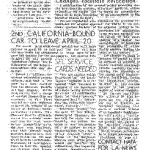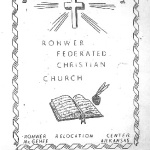Rohwer Outpost (newspaper)
| Publication Name | Rohwer Outpost |
|---|---|
| Camp | Rohwer |
| Start of Publication | October 24, 1942 |
| End of Publication | July 21, 1945 |
| Successor | Rohwer Relocator |
| Mode of Production | mimeographed |
| Staff Members | Editors-Bean Takeda, Barry Saiki, Managing Editors-Mutsuyo Uyeno, Jim Doi, Kaz Oshiki, News Editor-Dick Honma, Copy Editor-Mary Yamashita, Features Editor-Sus Hasegawa, Sports Editor-Kango Kunitsugu, Arts Editor-Gengo Miyahara, Society Editors-Vicky Konman, Iris Kobayashi, Reporters-Chieko Kikuchi, Kazu Fukuya, Harry Oshima |
The Rohwer Outpost (October 24, 1942 to July 21, 1945) was the newspaper of the Rohwer , Arkansas, concentration camp.
The War Relocation Authority camp newspapers kept incarcerated Nikkei informed of a variety of information, including administrative announcements, orders, events, vital statistics, news from other camps, and other necessary information concerning daily life in the camps. (See Newspapers in camp .) Story coverage was comparable to what one might typically expect of a small town newspaper, with nearly identical coverage in all ten camps of social events, religious activities (both Buddhist and Christian), school activities and sports , crimes and accidents, in addition to regular posts concerning WRA rules and regulations. Nearly every paper included diagrams and maps of the camp layouts and geographical overviews to allow residents to get a bearing of their locations; payroll announcements, instructions on obtaining work leaves and classified ads for work opportunities; lost and found items; and some editorial column that was reflective of its Japanese American staff editor. Reporters and editors were classified as skilled and professional workers respectively and received monthly payments. The wage scale was set at $12 or $16 a month for assistants and reporters and $19 for top editors, although no labor was compulsory. All ten camps had both English and Japanese language newspapers. Despite its democratic appearance, the camp newspapers in reality were hardly a "free" press. All newspapers were subject to some sort of editorial interference, in some cases even overt censorship, and camp authority retained the power to "supervise" newspapers and even to suspend them in the event that they were judged to have disregarded certain responsibilities enumerated in WRA policy. [1]
The first issue of the Rohwer Outpost newspaper appeared on October 24, 1942, five weeks after the camp, located in McGee, Arkansas, began receiving inmates. The early issues of the Outpost were typically a three-column, six-paged affair written, edited, typed, and mimeograph printed on site. As with other camp newspapers, the staff consisted mostly of Nisei with some previous newspaper experience, at the very least with the wartime assembly center papers.
The Outpost was published every Wednesday and Saturday, and provided Rohwer's residents with basic information related to daily life and the administration of the project, with additional editorial comments on controversial matters such as repatriation and the creation of the Tule Lake Segregation Center in late 1943. However, it notably ignored other significant local stories and declined to editorialize on some issues of interest to the residents. [2] In its inaugural issue, the editors hoped to create a "good newspaper... a readable newspaper [that] carries interesting features, straightforward editorials, unusual happenings." Initially, Bean Takeda (from Santa Anita Assembly Center) and Barry Saiki (from the Stockton (detention facility)|Stockton]] Assembly Center) were named co-editors. Reported differences in editorial direction split the partnership, although both men eventually took individual turns as editor-in-chief, responsible for writing the paper's editorial column. Although reports officers at other WRA centers occasionally or regularly controlled the contents of the center newspapers, numerous individuals who were at Rohwer agree that the Outpost was uncensored by the center administration during Saiki's editorship and probably later as well. [3]
George Akimoto's editorial cartoon character, "Lil Dan'l" made his first appearance in the Outpost's second issue and continued as a familiar part of the paper for well over a year. The December 24, 1942 issue marked the arrival of the Jiho , a four-page Japanese language supplement that was largely a direct translation of the English paper.
Due to irregular weather patterns, farming was difficult despite relatively fertile soil. The climate also resulted in problems with mosquitoes and chiggers, which led to health warnings in the paper. On November 6, 1943, the Outpost staff produced an 82-page magazine, The Pen , that observed the one-year anniversary at Rohwer, summarizing residents' life and the newspapers' top stories. The Outpost also featured stories on juvenile delinquency, fire breakouts, the Dies committee reports, the impact of camp life both morally and spiritually on camp inmates, and the mixed reactions of camp residents in response to segregation policies, as families struggled to sort out their loyal from the disloyal sentiments and more inmates left for other opportunities in the Midwest and East Coast. The June 23, 1945 issue included a memorial dedication to deceased Nisei soldiers that was designed and constructed by Koheiji Horizawa.
The newspaper's last issue was released on July 21, 1945, before it was transformed into the Rohwer Relocator , a bulletin issued by the WRA that focused on camp closing procedures and relocation opportunities for the remaining inmates. Rohwer War Relocation Center officially closed on November 30, 1945.
For More Information
Friedlander, Jay. "Journalism Behind Barbed Wire, 1942-1944: An Arkansas Relocation Center Newspaper." Journalism Quarterly 62.2 (Summer 1985): 243-46.
Howard, John. Concentration Camps on the Home Front: Japanese Americans in the House of Jim Crow . Chicago: University of Chicago Press, 2008.
Stevens, John D. "From Behind Barbed Wire: Freedom of the Press in WWII Japanese Centers." Journalism Quarterly 48 (1971): 279-87.
Mizuno, Takeya. "The Creation of the 'Free' Press in Japanese American Camps: The War Relocation Authority's Planning and Making of the Camp Newspaper Policy." Journalism & Mass Communication Quarterly 78 (Autumn 2001): 503-518.
Footnotes
- ↑ Takeya Mizuno, "The Creation of the 'Free Press' in Japanese American Camps" Journalism & Mass Communication Quarterly 78.3 (2001), 514.
- ↑ Jay Friedlander, "Journalism Behind Barbed Wire, 1942-1944: An Arkansas Relocation Center Newspaper," Journalism Quarterly , 62.2, Summer 1985, 243-46.
- ↑ Friedlander, "Journalism Behind Barbed Wire."
Last updated June 22, 2020, 7:15 p.m..

 Media
Media








